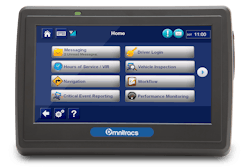The trucking industry has more than 18 months of experience with the new hours-of-service (HOS) rules. And with widespread use of electronic logging devices and advanced planning tools, fleets and drivers are staying compliant and productive.
 Dean Croke, vice president of Omnitracs Analytics, recommends drivers use the apps shown here to help manage their sleep. Click to enlarge
Dean Croke, vice president of Omnitracs Analytics, recommends drivers use the apps shown here to help manage their sleep. Click to enlargeAs for the safety impact, are drivers less fatigued now than before the new rule went into effect in July, 2013? Have fatigue levels gone up or down since December 16, 2014, when Congress suspended the new 34-hour restart provision?
Both the Federal Motor Carrier Safety Administration and the transportation industry would like to answer these questions to redraw the battle line between safety and productivity.
The current HOS rule is based on some laws of human physiology, but there are some points of contention. What can be said for certain is that to manage driver fatigue, fleets have to go beyond compliance, says Dean Croke, who is an expert on driver fatigue and vice president of Omnitracs Analytics.
The July, 2013, HOS rule shortened drivers’ maximum workweek from 82 hours to 70 hours. It also added a new requirement that drivers take a 30-minute break in the first eight hours of coming on duty.
The more controversial portion of the rule is that drivers can use the 34-hour restart only once per week (every 168 hours). Phil Byrd, past chairman of the American Trucking Associations, has used the example of a driver coming home on Friday after working 60 hours since he last used his 34-hour restart.
Byrd, the president and CEO of Bulldog Hiway Express in Charleston, S.C., spoke at the CCJ Summer Symposium last June.
The driver would have 10 hours (70-60) of on-duty time left to use for the remainder of the week. If he stayed off-duty for 40 hours at home, that would not be enough to qualify for a restart since 168 hours had not lapsed.
This would put the driver in a predicament. Rather than leave the house on Sunday when the roads are the least congested, he must either wait another 10 hours to leave on Monday with a fresh set of hours or leave on Sunday and run out of hours in the middle of the week.
The 34-hour reset must also include two consecutive 1-5 a.m. periods in the 34-hour reset. This much is based on science, but Croke recommends that drivers get at least two days of nighttime sleep in a 7-day period regardless of whether or not they reset their hours.
Drivers cannot function at a normal level without this, he says.
Croke was one of the founders of FleetRisk Advisors who created an advanced software model that predicts driver fatigue. It also has models that predict accident frequency, workers comp claims and driver turnover. The company was acquired by Qualcomm and then sold to Vista Equity Partners in November, 2013, as a subsidiary of Omnitracs.
The fatigue model of Omnitracs Analytics uses hours-of-service data from electronic logs to predict when drivers obtained sleep. For each driver it calculates a fatigue score on a scale of 100, with 100 being the most extreme case of fatigue.
Fleets use the technology to identify the exceptions – the drivers with a fatigue score over a certain number such as 60. The drivers in a truckload operation with a score of 60 or above comprise about 12 to 15 percent of the fleet, he says. The data shows that fatigued drivers at this level are five times more likely to have a DOT preventable accident.
One of the first fleets to use FleetRisk’s fatigue model was C.R. England. In 2007, the Salt Lake City-based refrigerated carrier created its own HOS rules using sleep physiology. Drivers have to get two days of nighttime sleep every seven-day period and at least 6 hours of sleep every 24 hours to be compliant.
The fleet also encourages drivers to take naps in the afternoon when they need them, Croke says.
Half of its drivers went through a sleep training program led by Croke. Drivers also received training videos in the cab through the Omnitracs MCP 200 platform. Of the group of drivers who completed the training, only one was involved in a rollover. The other half of the fleet was compliant with federal HOS rules but had 14 rollovers. While the number of rollovers may seem high, C.R. England is a large carrier. The rollover rate for the latter group of drivers would be the same at most carriers, he says.
Less-than-truckload carrier Dayton Freight Lines recently implemented the fatigue management system from Omnitracs Analytics. After completing the training, Omnitracs surveyed the drivers; 94 percent believed they will be less fatigued and more alert when driving.
“Education alone fills in the gaps for people,” Croke says.
To get actual data on driver fatigue, rather than make a prediction, Croke encourages his customers to have drivers wear an ActiGraph watch to measure their sleep. He also encourages drivers to use apps on their smartphones to measure and optimize their sleep quality.
“If drivers feel better, they are more likely to use the techniques the next night,” he says. Besides improving safety, a well-rested driver will get better fuel economy, be less likely to leave, and have higher on-time service.
The fatigue model of Omnitracs Analytics is scalable for carriers of all sizes, as long as they use electronic logs, he says. The model is offered as a subscription service with pricing based on the number of drivers with a one-time setup fee.
The model presents information through an online management portal called the Driving Center. The main dashboard shows drivers’ fatigue scores. Clicking on one opens up more details, like the number of days a driver has worked in succession, the number of periods of night sleep a driver got in the last seven days, and the number of days he has had more than 3 hours of sleep at a time.













